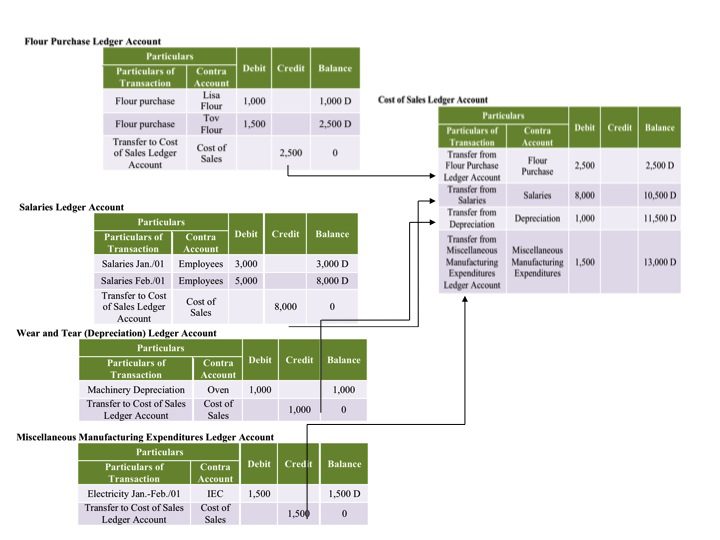This item, which includes all four of the above-mentioned expenditure items, is called cost of sales, or direct expenditures. The term direct expenditures is used to indicate that these expenditures are in direct proportion to the volume of sales. The greater sales are, the higher the direct expenditures. For example each additional loaf of bread produced by the Victor Bakery increases flour expenditures by $2.
In practice, the expenditure registered during the year in each of these expenditure ledger accounts (Raw Materials, Salaries, Wear and Tear, and Miscellaneous Manufacturing Expenditures) is transferred at the end of the year to a general ledger account, called Cost of Sales as follows:

The Value of Cost of Sales Items Per Product Unit
A company usually calculates for its own internal needs the value of the elements of its cost of sales for each production unit that it manufactures.
For Example, a bakery calculates the value of the elements of its cost of sales per loaf of bread that it makes, i.e. the value of the flour element in each loaf of bread and the value of the salaries, equipment wear and tear, and miscellaneous expenditures elements required to make one loaf of bread. In this example, assume that the bakery sells a loaf of bread for $5, and that the value of the elements of cost of sales is $3 per loaf. This figure will be used in the following explanations.
Registration of Inventory of Products in Bookkeeping
Were the bakery left at the end of the year with no bread inventory, all the expenditures included under cost of sales would appear as an expenditures in the Profit and Loss Statement prepared by the company at the end of the year.
As an Example, however, assume that the bakery has 100 loaves of bread remaining at the end of the year. In this case, all the elements used to prepare the bread (flour, salaries, etc.), which have already been registered as expenditures and transferred to the Cost of Sales Ledger Account, are not part of the expenditure for bread that has already been sold. In order to prevent this “misuse”, the bread inventory is “transferred” to a “virtual warehouse”, called an “Inventory of Finished Products”. The transfer involves a sum equal to the Direct Expenditures (cost of sales) incurred in producing the quantity of bread transferred to the warehouse.
The registration takes place in two bookkeeping ledger accounts, as follows.
It is assumed that the cost of sales subtracted for 100 loaves of bread transferred is $300.C
Cost of Sales Ledgeraccount
| Particulars | Debit | Credit | Balance | |
| Particulars of Transactions | Contra Account | |||
| Greg James | 4,000 | 300D | ||
| Transfer to finished products inventory | Finished Products Inventory | 300 | 0 | |
Finished Products Inventory Ledger Account
| Particulars | Debit | Credit | Balance | |
| Particulars of Transactions | Contra Account | |||
| Transfer from Cost of Sales | Cost of Sales | 300 | 300D | |
The remaining balance in the Cost of Sales Ledger Account is transferred to the Profit and Loss Statement, and the ledger account is left with a 0 balance.
Return Transfer from the Products Inventory Ledger Account to the Cost of Sales Ledger Account
At the beginning of the year (immediately after the annual financial statements are prepared), the bread is transferred from the “virtual warehouse” to the Cost of Sales Ledger Account. The following transactions are registered on the Cost of Sales Ledger Account and the Products Inventory Ledger Account:
Cost of Sales Ledger Account
| Particulars | Debit | Credit | Balance | |
| Particulars of Transactions | Contra Account | |||
| Transfer from Finished Proucts Inventory | Finished Products Inventory | 300 | 300D | |
Finished Products Inventory Ledger Account
| Particulars | Debit | Credit | Balance | |
| Particulars of Transactions | Contra Account | |||
| 300D | ||||
| Transfer to Cost of Sales | Cost of Sales | 300 | ||
The registration in the Cost of Sales Ledger Account remains until the end of the year, when the end-of-year balance in each of the expenditure elements (flour, salaries, wear and tear, and miscellaneous expenditures) is again added to it.
If no bread inventory is left at the end of the next year, then the entire sum registered in the Cost of Sales Ledger Account will be transferred to the Profit and Loss Statement. If inventory of bread remains, the transaction described above between the Cost of Sales and Product Inventory Ledger Accounts is repeated.









